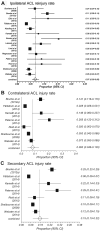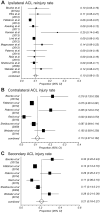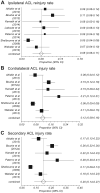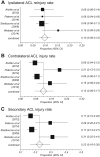Risk of Secondary Injury in Younger Athletes After Anterior Cruciate Ligament Reconstruction: A Systematic Review and Meta-analysis
- PMID: 26772611
- PMCID: PMC5501245
- DOI: 10.1177/0363546515621554
Risk of Secondary Injury in Younger Athletes After Anterior Cruciate Ligament Reconstruction: A Systematic Review and Meta-analysis
Abstract
Background: Injury to the ipsilateral graft used for reconstruction of the anterior cruciate ligament (ACL) or a new injury to the contralateral ACL are disastrous outcomes after successful ACL reconstruction (ACLR), rehabilitation, and return to activity. Studies reporting ACL reinjury rates in younger active populations are emerging in the literature, but these data have not yet been comprehensively synthesized.
Purpose: To provide a current review of the literature to evaluate age and activity level as the primary risk factors in reinjury after ACLR.
Study design: Systematic review and meta-analysis.
Methods: A systematic review of the literature was conducted via searches in PubMed (1966 to July 2015) and EBSCO host (CINAHL, Medline, SPORTDiscus [1987 to July 2015]). After the search and consultation with experts and rating of study quality, 19 articles met inclusion for review and aggregation. Population demographic data and total reinjury (ipsilateral and contralateral) rate data were recorded from each individual study and combined using random-effects meta-analyses. Separate meta-analyses were conducted for the total population data as well as the following subsets: young age, return to sport, and young age + return to sport.
Results: Overall, the total second ACL reinjury rate was 15%, with an ipsilateral reinjury rate of 7% and contralateral injury rate of 8%. The secondary ACL injury rate (ipsilateral + contralateral) for patients younger than 25 years was 21%. The secondary ACL injury rate for athletes who return to a sport was also 20%. Combining these risk factors, athletes younger than 25 years who return to sport have a secondary ACL injury rate of 23%.
Conclusion: This systematic review and meta-analysis demonstrates that younger age and a return to high level of activity are salient factors associated with secondary ACL injury. These combined data indicate that nearly 1 in 4 young athletic patients who sustain an ACL injury and return to high-risk sport will go on to sustain another ACL injury at some point in their career, and they will likely sustain it early in the return-to-play period. The high rate of secondary injury in young athletes who return to sport after ACLR equates to a 30 to 40 times greater risk of an ACL injury compared with uninjured adolescents. These data indicate that activity modification, improved rehabilitation and return-to-play guidelines, and the use of integrative neuromuscular training may help athletes more safely reintegrate into sport and reduce second injury in this at-risk population.
Keywords: ACL injury; ACL revision; knee injury; knee injury prevention.
© 2016 The Author(s).
Conflict of interest statement
The authors declared that they have no conflicts of interest in the authorship and publication of this contribution.
Figures






References
-
- Anterior Cruciate Ligament Injury: Surgical Considerations. Rosemont, IL: American Academy of Orthopaedic Surgeons; 2009.
-
- Ahldén M, Samuelsson K, Sernert N, Forssblad M, Karlsson J, Kartus J. The Swedish National Anterior Cruciate Ligament Register: a report on baseline variables and outcomes of surgery for almost 18,000 patients. Am J Sports Med. 2012;40(10):2230–2235. - PubMed
-
- Andernord D, Desai N, Bjornsson H, Ylander M, Karlsson J, Samuels-son K. Patient predictors of early revision surgery after anterior cruciate ligament reconstruction: a cohort study of 16,930 patients with 2-year follow-up. Am J Sports Med. 2015;43(1):121–127. - PubMed
-
- Borchers JR, Pedroza A, Kaeding C. Activity level and graft type as risk factors for anterior cruciate ligament graft failure a case-control study. Am J Sports Med. 2009;37(12):2362–2367. - PubMed
-
- Bourke HE, Gordon DJ, Salmon LJ, Waller A, Linklater J, Pinczewski LA. The outcome at 15 years of endoscopic anterior cruciate ligament reconstruction using hamstring tendon autograft for ‘isolated’ anterior cruciate ligament rupture. J Bone Joint Surg Br. 2012;94(5):630–637. - PubMed
Publication types
MeSH terms
Grants and funding
LinkOut - more resources
Full Text Sources
Other Literature Sources
Medical
Miscellaneous

